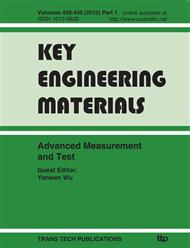[1]
J. C. Bezdek. Fuzzy mathematics in pattern classification. Ph.D. dissertation, Dept. Appl. Math., Cornell Univ., Ithaca, New York (1973).
Google Scholar
[2]
J. C. Bezdek. Pattern Recognition with Fuzzy Objective Function Algorithms. Plenum Press, New York (1981).
Google Scholar
[3]
D. Özdemir, L. Akarun. Fuzzy algorithms for combined quantization and dithering. IEEE Trans. Image Process., vol. 10, no. 6, (2001), pp.923-931.
DOI: 10.1109/83.923288
Google Scholar
[4]
R. Krishnapuram and J. Keller. A possibilistic approach to clustering. IEEE Trans. Fuzzy Systems, vol. 1, no. 2, (1993), 98-110.
DOI: 10.1109/91.227387
Google Scholar
[5]
R. Krishnapuram and J. Keller. The possibilistic c-means algorithm: insights and recommendations, IEEE Trans. Fuzzy Systems, vol. 4, no. 3, (1996), pp.385-393.
DOI: 10.1109/91.531779
Google Scholar
[6]
M. Barni, V. Cappellini and A. Mecocci. Comments on a possibilistic approach to clustering. IEEE Trans. Fuzzy Systems, vol. 4, No. 3, (1996), pp.393-396.
DOI: 10.1109/91.531780
Google Scholar
[7]
J. - S. Zhang, Y. - W. Leung. Improved possibilistic c-means clustering algorithms. IEEE Trans. Fuzzy Systems, vol. 12, no. 2, (2004), 209-217.
DOI: 10.1109/tfuzz.2004.825079
Google Scholar
[8]
M. S. Yang, K. L. Wu. Unsupervised possibilistic clustering. Pattern Recognition, vol. 39, no. 1, (2006), 5-21.
Google Scholar
[9]
N. R. Pal, K. Pal, and J. C. Bezdek. A possibilistic fuzzy c-means clustering algorithm. IEEE Trans. Fuzzy Systems, vol. 13, No. 4, (2005), pp.517-530.
DOI: 10.1109/tfuzz.2004.840099
Google Scholar
[10]
N. R. Pal, K. Pal, and J. C. Bezdek. A new hybrid c-means clustering model. Proceedings of the IEEE International Conference On Fuzzy Systems, vol. 1, (2004), pp.179-184.
DOI: 10.1109/fuzzy.2004.1375713
Google Scholar
[11]
J. C. Bezdek, J. M. Keller, R. Krishnapuram, L. I. Kuncheva and N. R. Pal. Will the real Iris data stand up?, IEEE Trans. Fuzzy Syst., vol. 7, no. 3, (1999), pp.368-369.
DOI: 10.1109/91.771092
Google Scholar
[12]
H. Timm, C. Borgelt, C. Döring, R. Kruse. An extension to possibilistic fuzzy cluster analysis, Fuzzy Sets and Systems, vol. 147, no. 1, (2004), pp.3-16.
DOI: 10.1016/j.fss.2003.11.009
Google Scholar


